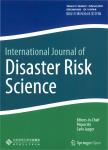Glacial Lake Outburst Flood Disasters and Integrated Risk Management in China
Glacial Lake Outburst Flood Disasters and Integrated Risk Management in China作者机构:State Key Laboratory of Cryospheric Sciences Northwest Institute of Eco-Environment and Resources Chinese Academy of Sciences
出 版 物:《International Journal of Disaster Risk Science》 (国际灾害风险科学学报(英文版))
年 卷 期:2017年第8卷第4期
页 面:493-497页
核心收录:
学科分类:083002[工学-环境工程] 0830[工学-环境科学与工程(可授工学、理学、农学学位)] 081504[工学-水利水电工程] 08[工学] 0815[工学-水利工程]
基 金:the National Natural Science Foundation (41690143) the National Social Science Foundation of China (Grant No.14BGL137) the Technology Services Network Program of Cold and Arid Regions Environmental and Engineering Research Institute, the Chinese Academy of Sciences (HHS-TSS-STS-1501) the National Basic Research Program of China (2013CBA01808)
主 题:China Glacial lake outburst flood disasters Risk management Tibetan Plateau
摘 要:High-risk areas for glacial lake outburst flood(GLOF) disasters in China are mainly concentrated in the middle-eastern Himalayas and Nyainqe?ntanglha(Nyenchen Tanglha Mountains), Tibetan Plateau. In the past 20 years, glaciers in these regions have retreated and thinned rapidly as a response to regional climate warming,leading to the formation of new glacial lakes and the expansion of existing glacial lakes. These areas are located in the border belt between the Indian and the Eurasian plates, where tectonic seismic activity is also frequent and intense. Earthquakes have often compromised the stability of mountain slopes, glaciers, and moraine dams, resulting in an imbalance in the state of glacial lakes and an increase of loose materials in valleys. It is foreseeable that the possibility of GLOFs and disaster occurrence will be great in the context of frequent earthquakes and continued climate warming. This article presents the temporal and spatial characteristics of GLOF disasters, as well as the conditions and mechanisms of GLOF disaster formation,and proposes an integrated risk management strategy to cope with GLOF disasters. It aims to facilitate the mitigation of the impacts of GLOF disasters on mountain economic and social systems, and improve disaster risk analysis, as well as the capability of risk management and disaster prevention and reduction.



